微积分英文课件PPT (6)
- 格式:ppt
- 大小:654.00 KB
- 文档页数:25
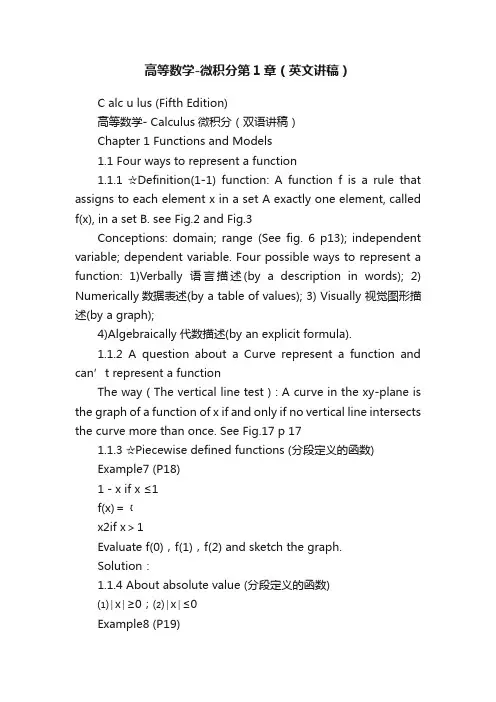
高等数学-微积分第1章(英文讲稿)C alc u lus (Fifth Edition)高等数学- Calculus微积分(双语讲稿)Chapter 1 Functions and Models1.1 Four ways to represent a function1.1.1 ☆Definition(1-1) function: A function f is a rule that assigns to each element x in a set A exactly one element, called f(x), in a set B. see Fig.2 and Fig.3Conceptions: domain; range (See fig. 6 p13); independent variable; dependent variable. Four possible ways to represent a function: 1)Verbally语言描述(by a description in words); 2) Numerically数据表述(by a table of values); 3) Visually 视觉图形描述(by a graph);4)Algebraically 代数描述(by an explicit formula).1.1.2 A question about a Curve represent a function and can’t represent a functionThe way ( The vertical line test ) : A curve in the xy-plane is the graph of a function of x if and only if no vertical line intersects the curve more than once. See Fig.17 p 171.1.3 ☆Piecewise defined functions (分段定义的函数)Example7 (P18)1-x if x ≤1f(x)=﹛x2if x>1Evaluate f(0),f(1),f(2) and sketch the graph.Solution:1.1.4 About absolute value (分段定义的函数)⑴∣x∣≥0;⑵∣x∣≤0Example8 (P19)Sketch the graph of the absolute value function f(x)=∣x∣.Solution:1.1.5☆☆Symmetry ,(对称) Even functions and Odd functions (偶函数和奇函数)⑴Symmetry See Fig.23 and Fig.24⑵①Even functions: If a function f satisfies f(-x)=f(x) for every number x in its domain,then f is call an even function. Example f(x)=x2 is even function because: f(-x)= (-x)2=x2=f(x)②Odd functions: If a function f satisfie s f(-x)=-f(x) for every number x in its domain,thenf is call an odd function. Example f(x)=x3 is even function because: f(-x)=(-x)3=-x3=-f(x)③Neither even nor odd functions:1.1.6☆☆Increasing and decreasing function (增函数和减函数)⑴Definition(1-2) increasing and decreasing function:① A function f is called increasing on an interval I if f(x1)<f(x2) whenever x1<x2 in I. ①A function f is called decreasing on an interval I if f(x1)>f(x2) whenever x1<x2 in I.See Fig.26. and Fig.27. p211.2 Mathematical models: a catalog of essential functions p251.2.1 A mathematical model p25A mathematical model is a mathematical description of a real-world phenomenon such as the size of a population, the demand for a product, the speed of a falling object, the concentration of a product in a chemical reaction, the life expectancy of a person at birth, or the cost of emission reduction.1.2.2 Linear models and Linear function P261.2.3 Polynomial P27A function f is called a polynomial ifP(x) =a n x n+a n-1x n-1+…+a2x2+a1x+a0Where n is a nonnegative integer and the numbers a0,a1,a2,…,a n-1,a n are constants called the coefficients of the polynomial. The domain of any polynomial is R=(-∞,+∞).if the leading coefficient a n≠0, then the degree of the polynomial is n. For example, the function P(x) =5x6+2x5-x4+3x-9⑴Quadratic function example: P(x) =5x2+2x-3 二次函数(方程)⑵Cubic function example: P(x) =6x3+3x2-1 三次函数(方程)1.2.4Power functions幂函数P30A function of the form f(x) =x a,Where a is a constant, is called a power function. We consider several cases:⑴a=n where n is a positive integer ,(n=1,2,3,…,)⑵a=1/n where n is a positive integer,(n=1,2,3,…,) The function f(x) =x1/n⑶a=n-1 the graph of the reciprocal function f(x) =x-1 反比函数1.2.5Rational function有理函数P 32A rational function f is a ratio of two polynomials:f(x)=P(x) /Q(x)1.2.6Algebraic function代数函数P32A function f is called algebraic function if it can be constructed using algebraic operations ( such as addition,subtraction,multiplication,division,and taking roots) starting with polynomials. Any rational function is automatically an algebraic function. Examples: P 321.2.7Trigonometric functions 三角函数P33⑴f(x)=sin x⑵f(x)=cos x⑶f(x)=tan x=sin x / cos x1.2.8Exponential function 指数函数P34The exponential functions are the functions the form f(x) =a x Where the base a is a positive constant.1.2.9Transcendental functions 超越函数P35These are functions that are not a algebraic. The set of transcendental functions includes the trigonometric,inverse trigonometric,exponential,and logarithmic functions,but it also includes a vast number of other functions that have never been named. In Chapter 11 we will study transcendental functions that are defined as sums of infinite series.1.2 Exercises P 35-381.3 New functions from old functions1.3.1 Transformations of functions P38⑴Vertical and Horizontal shifts (See Fig.1 p39)①y=f(x)+c,(c>0)shift the graph of y=f(x) a distance c units upward.②y=f(x)-c,(c>0)shift the graph of y=f(x) a distance c units downward.③y=f(x+c),(c>0)shift the graph of y=f(x) a distance c units to the left.④y=f(x-c),(c>0)shift the graph of y=f(x) a distance c units to the right.⑵ V ertical and Horizontal Stretching and Reflecting (See Fig.2 p39)①y=c f(x),(c>1)stretch the graph of y=f(x) vertically bya factor of c②y=(1/c) f(x),(c>1)compress the graph of y=f(x) vertically by a factor of c③y=f(x/c),(c>1)stretch the graph of y=f(x) horizontally by a factor of c.④y=f(c x),(c>1)compress the graph of y=f(x) horizontally by a factor of c.⑤y=-f(x),reflect the graph of y=f(x) about the x-axis⑥y=f(-x),reflect the graph of y=f(x) about the y-axisExamples1: (See Fig.3 p39)y=f( x) =cos x,y=f( x) =2cos x,y=f( x) =(1/2)cos x,y=f( x) =cos(x/2),y=f( x) =cos2xExamples2: (See Fig.4 p40)Given the graph y=f( x) =( x)1/2,use transformations to graph y=f( x) =( x)1/2-2,y=f( x) =(x-2)1/2,y=f( x) =-( x)1/2,y=f( x) =2 ( x)1/2,y=f( x) =(-x)1/21.3.2 Combinations of functions (代数组合函数)P42Algebra of functions: Two functions (or more) f and g through the way such as add, subtract, multiply and divide to combined a new function called Combination of function.☆Definition(1-2) Combination function: Let f and g be functions with domains A and B. The functions f±g,f g and f /g are defined as follows: (特别注意符号(f±g)( x) 定义的含义)①(f±g)( x)=f(x)±g( x),domain =A∩B②(f g)( x)=f(x) g( x),domain =A∩ B③(f /g)( x)=f(x) /g( x),domain =A∩ B and g( x)≠0Example 6 If f( x) =( x)1/2,and g( x)=(4-x2)1/2,find functions y=f(x)+g( x),y=f(x)-g( x),y=f(x)g( x),and y=f(x) /g( x)Solution: The domain of f( x) =( x)1/2 is [0,+∞),The domain of g( x) =(4-x2)1/2 is interval [-2,2],The intersection of the domains of f(x) and g( x) is[0,+∞)∩[-2,2]=[0,2]Thus,according to the definitions, we have(f+g)( x)=( x)1/2+(4-x2)1/2,domain [0,2](f-g)( x)=( x)1/2-(4-x2)1/2,domain [0,2](f g)( x)=f(x) g( x) =( x)1/2(4-x2)1/2=(4 x-x3)1/2domain [0,2](f /g)( x)=f(x)/g( x)=( x)1/2/(4-x2)1/2=[ x/(4-x2)]1/2 domain [0,2)1.3.3☆☆Composition of functions (复合函数)P45☆Definition(1-3) Composition function: Given two functions f and g the composite func tion f⊙g (also called the composition of f and g ) is defined by(f⊙g)( x)=f( g( x)) (特别注意符号(f⊙g)( x) 定义的含义)The domain of f⊙g is the set of all x in the domain of g such that g(x) is in the domain of f . In other words, (f⊙g)(x) is defined whenever both g(x) and f (g (x)) are defined. See Fig.13 p 44 Example7 If f (g)=( g)1/2 and g(x)=(4-x3)1/2find composite functions f⊙g and g⊙f Solution We have(f⊙g)(x)=f (g (x) ) =( g)1/2=((4-x3)1/2)1/2(g⊙f)(x)=g (f (x) )=(4-x3)1/2=[4-((x)1/2)3]1/2=[4-(x)3/2]1/2Example8 If f (x)=( x)1/2 and g(x)=(2-x)1/2find composite function s①f⊙g ②g⊙f ③f⊙f④g⊙gSolution We have①f⊙g=(f⊙g)(x)=f (g (x) )=f((2-x)1/2)=((2-x)1/2)1/2=(2-x)1/4The domain of (f⊙g)(x) is 2-x≥0 that is x ≤2 {x ︳x ≤2 }=(-∞,2]②g⊙f=(g⊙f)(x)=g (f (x) )=g (( x)1/2 )=(2-( x)1/2)1/2The domain of (g⊙f)(x) is x≥0 and 2-( x)1/2x ≥0 ,that is( x)1/2≤2 ,or x ≤ 4 ,so the domain of g⊙f is the closed interval[0,4]③f⊙f=(f⊙f)(x)=f (f(x) )=f((x)1/2)=((x)1/2)1/2=(x)1/4The domain of (f⊙f)(x) is [0,∞)④g⊙g=(g⊙g)(x)=g (g(x) )=g ((2-x)1/2 )=(2-(2-x)1/2)1/2The domain of (g⊙g)(x) is x-2≥0 and 2-(2-x)1/2≥0 ,that is x ≤2 and x ≥-2,so the domain of g⊙g is the closed interval[-2,2]Notice: g⊙f⊙h=f (g(h(x)))Example9Example10 Given F (x)=cos2( x+9),find functions f,g,and h such that F (x)=f⊙g⊙h Solution Since F (x)=[cos ( x+9)] 2,that is h (x)=x+9 g(x)=cos x f (x)=x2Exercise P 45-481.4 Graphing calculators and computers P481.5 Exponential functions⑴An exponential function is a function of the formf (x)=a x See Fig.3 P56 and Fig.4Exponential functions increasing and decreasing (单调性讨论)⑵Lows of exponents If a and b are positive numbers and x and y are any real numbers. Then1) a x+y=a x a y2) a x-y=a x / a y3) (a x)y=a xy4) (ab)x+y =a x b x⑶about the number e f (x)=e x See Fig. 14,15 P61Some of the formulas of calculus will be greatly simplified if we choose the base a .Exercises P 62-631.6 Inverse functions and logarithms1.6.1 Definition(1-4) one-to-one function: A function f iscalled a one-to-one function if it never takes on the same value twice;that is,f (x1)≠f (x2),whenever x1≠x2( 注解:不同的自变量一定有不同的函数值,不同的自变量有相同的函数值则不是一一对应函数) Example: f (x)=x3is one-to-one function.f (x)=x2 is not one-to-one function, See Fig.2,3,4 ☆☆Definition(1-5) Inverse function:Let f be a one-to-one function with domain A and range B. Then its inverse function f -1(y)has domain B and range A and is defined byf-1(y)=x f (x)=y for any y in Bdomain of f-1=range of frange of f-1=domain of f( 注解:it says : if f maps x into y, then f-1maps y back into x . Caution: If f were not one-to-one function,then f-1 would not be uniquely defined. )Caution: Do not mistake the-1 in f-1for an exponent. Thus f-1(x)=1/ f(x) Because the letter x is traditionally used as the independent variable, so when we concentrate on f-1(y) rather than on f-1(y), we usually reverse the roles of x and y in Definition (1-5) and write as f-1(x)=y f (x)=yWe get the following cancellation equations:f-1( f(x))=x for every x in Af (f-1(x))=x for every x in B See Fig.7 P66Example 4 Find the inverse function of f(x)=x3+6Solution We first writef(x)=y=x3+6Then we solve this equation for x:x3=y-6x=(y-6)1/3Finally, we interchange x and y:y=(x-6)1/3That is, the inverse function is f-1(x)=(x-6)1/3( 注解:The graph of f-1 is obtained by reflecting the graph of f about the line y=x. ) See Fig.9、8 1.6.2 Logarithmic function If a>0 and a≠1,the exponential function f (x)=a x is either increasing or decreasing and so it is one-to-one function by the Horizontal Line Test. It therefore has an inverse function f-1,which is called the logarithmic function with base a and is denoted log a,If we use the formulation of an inverse function given by (See Fig.3 P56)f-1(x)=y f (x)=yThen we havelogx=y a y=xThe logarithmic function log a x=y has domain (0,∞) and range R.Usefully equations:①log a(a x)=x for every x∈R②a log ax=x for every x>01.6.3 ☆Lows of logarithms :If x and y are positive numbers, then①log a(xy)=log a x+log a y②log a(x/y)=log a x-log a y③log a(x)r=r log a x where r is any real number1.6.4 Natural logarithmsNatural logarithm isl og e x=ln x =ythat is①ln x =y e y=x② ln(e x)=x x∈R③e ln x=x x>0 ln e=1Example 8 Solve the equation e5-3x=10Solution We take natural logarithms of both sides of the equation and use ②、③ln (e5-3x)=ln10∴5-3x=ln10x=(5-ln10)/3Example 9 Express ln a+(ln b)/2 as a single logarithm.Solution Using laws of logarithms we have:ln a+(ln b)/2=ln a+ln b1/2=ln(ab1/2)1.6.5 ☆Change of Base formula For any positive number a (a≠1), we havel og a x=ln x/ ln a1.6.6 Inverse trigonometric functions⑴Inverse sine function or Arcsine functionsin-1x=y sin y=x and -π/2≤y≤π / 2,-1≤x≤1 See Fig.18、20 P72Example13 ① sin-1 (1/2) or arcsin(1/2) ② tan(arcsin1/3)Solution①∵sin (π/6)=1/2,π/6 lies between -π/2 and π / 2,∴sin-1 (1/2)=π/6② Let θ=arcsin1/3,so sinθ=1/3tan(arcsin1/3)=tanθ=s inθ/cosθ=(1/3)/(1-s in2θ)1/2=1/(8)1/2Usefully equations:①sin-1(sin x)=x for -π/2≤x≤π / 2②sin (sin-1x)=x for -1≤x≤1⑵Inverse cosine function or Arccosine functioncos-1x=y cos y=x and 0 ≤y≤π,-1≤x≤1 See Fig.21、22 P73Usefully equations:①cos-1(cos x)=x for 0 ≤x≤π②cos (cos-1x)=x for -1≤x≤1⑶Inverse Tangent function or Arctangent functiontan-1x=y tan y=x and -π/2<y<π / 2 ,x∈R See Fig.23 P73、Fig.25 P74Example 14 Simplify the expression cos(ta n-1x).Solution 1 Let y=tan-1 x,Then tan y=x and -π/2<y<π / 2 ,We want find cos y but since tan y is known, it is easier to find sec y first:sec2y=1 +tan2y sec y=(1 +x2 )1/2∴cos(ta n-1x)=cos y =1/ sec y=(1 +x2)-1/2Solution 2∵cos(ta n-1x)=cos y∴cos(ta n-1x)=(1 +x2)-1/2⑷Other Inverse trigonometric functionscsc-1x=y∣x∣≥1csc y=x and y∈(0,π / 2]∪(π,3π / 2]sec-1x=y∣x∣≥1sec y=x and y∈[0,π / 2)∪[π,3π / 2]cot-1x=y x∈R cot y=x and y∈(0,π)Exercises P 74-85Key words and PhrasesCalculus 微积分学Set 集合Variable 变量Domain 定义域Range 值域Arbitrary number 独立变量Independent variable 自变量Dependent variable 因变量Square root 平方根Curve 曲线Interval 区间Interval notation 区间符号Closed interval 闭区间Opened interval 开区间Absolute 绝对值Absolute value 绝对值Symmetry 对称性Represent of a function 函数的表述(描述)Even function 偶函数Odd function 奇函数Increasing Function 增函数Increasing Function 减函数Empirical model 经验模型Essential Function 基本函数Linear function 线性函数Polynomial function 多项式函数Coefficient 系数Degree 阶Quadratic function 二次函数(方程)Cubic function 三次函数(方程)Power functions 幂函数Reciprocal function 反比函数Rational function 有理函数Algebra 代数Algebraic function 代数函数Integer 整数Root function 根式函数(方程)Trigonometric function 三角函数Exponential function 指数函数Inverse function 反函数Logarithm function 对数函数Inverse trigonometric function 反三角函数Natural logarithm function 自然对数函数Chang of base of formula 换底公式Transcendental function 超越函数Transformations of functions 函数的变换Vertical shifts 垂直平移Horizontal shifts 水平平移Stretch 伸张Reflect 反演Combinations of functions 函数的组合Composition of functions 函数的复合Composition function 复合函数Intersection 交集Quotient 商Arithmetic 算数。
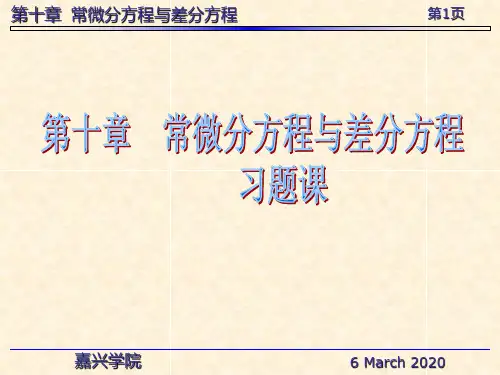
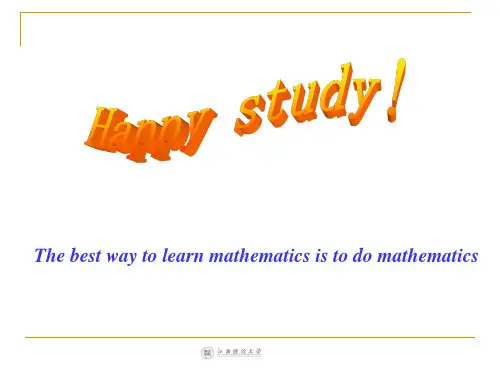



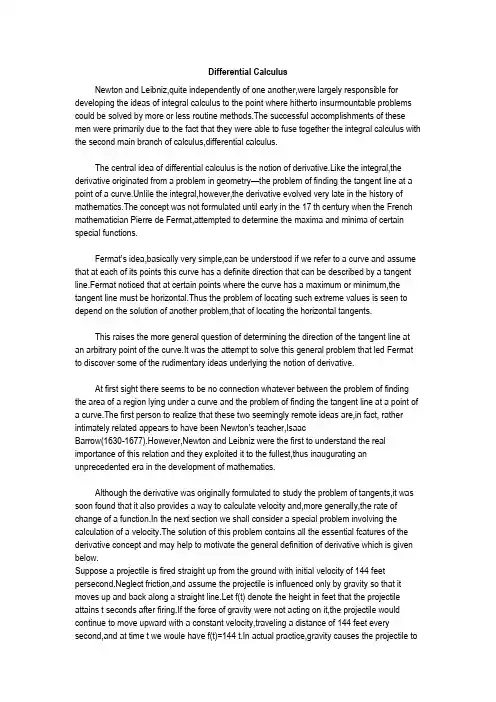
Differential CalculusNewton and Leibniz,quite independently of one another,were largely responsible for developing the ideas of integral calculus to the point where hitherto insurmountable problems could be solved by more or less routine methods.The successful accomplishments of these men were primarily due to the fact that they were able to fuse together the integral calculus with the second main branch of calculus,differential calculus.The central idea of differential calculus is the notion of derivative.Like the integral,the derivative originated from a problem in geometry—the problem of finding the tangent line at a point of a curve.Unlile the integral,however,the derivative evolved very late in the history of mathematics.The concept was not formulated until early in the 17th century when the French mathematician Pierre de Fermat,attempted to determine the maxima and minima of certain special functions.Fermat’s idea,basically very simple,can be understood if we refer to a curve and assume that at each of its points this curve has a definite direction that can be described by a tangent line.Fermat noticed that at certain points where the curve has a maximum or minimum,the tangent line must be horizontal.Thus the problem of locating such extreme values is seen to depend on the solution of another problem,that of locating the horizontal tangents.This raises the more general question of determining the direction of the tangent line at an arbitrary point of the curve.It was the attempt to solve this general problem that led Fermat to discover some of the rudimentary ideas underlying the notion of derivative.At first sight there seems to be no connection whatever between the problem of finding the area of a region lying under a curve and the problem of finding the tangent line at a point of a curve.The first person to realize that these two seemingly remote ideas are,in fact, rather intimately related appears to have been Newton’s teacher,IsaacBarrow(1630-1677).However,Newton and Leibniz were the first to understand the real importance of this relation and they exploited it to the fullest,thus inaugurating an unprecedented era in the development of mathematics.Although the derivative was originally formulated to study the problem of tangents,it was soon found that it also provides a way to calculate velocity and,more generally,the rate of change of a function.In the next section we shall consider a special problem involving the calculation of a velocity.The solution of this problem contains all the essential fcatures of the derivative concept and may help to motivate the general definition of derivative which is given below.Suppose a projectile is fired straight up from the ground with initial velocity of 144 fee t persecond.Neglect friction,and assume the projectile is influenced only by gravity so that it moves up and back along a straight line.Let f(t) denote the height in feet that the projectile attains t seconds after firing.If the force of gravity were not acting on it,the projectile would continue to move upward with a constant velocity,traveling a distance of 144 feet every second,and at time t we woule have f(t)=144 t.In actual practice,gravity causes the projectile toslow down until its velocity decreases to zero and then it drops back to earth.Physical experiments suggest that as the projectile is aloft,its height f(t) is given by the formula.The term –16t2 is due to the influence of gravity.Note that f(t)=0 when t=0 and whent=9.This means that the projectile returns to earth after 9 seconds and it is to be understood that formula (1) is valid only for 0<t<9.The problem we wish to consider is this:T o determine the velocity of the projectile at each instant of its motion.Before we can understand this problem,we must decide on what is meant by the velocity at each instant.T o do this,we introduce first the notion of average velocity during a time interval,say from time t to time t+h.This is defined to be the quotient. Change in distance during time interval =f(t+h)-f(t)/h.ength of time intervalThis quotient,called a difference quotient,is a number which may be calculated whenever both t and t+h are in the interval[0,9].The number h may be positive or negative,but not zero.We shall keep t fixed and see what happens to the difference quotient as we take values of h with smaller and smaller absolute value.The limit process by which v(t) is obtained from the difference quotient is written symbolically as follows:The equation is used to define velocity not only for this particular example but,more generally,for any particle moving along a straight line,provided the position function f is such that the differerce quotient tends to a definite limit as h approaches zero.The example describe in the foregoing section points the way to the introduction of the concept of derivative.We begin with a function f defined at least on some open interval(a,b) on the x axis.Then we choose a fixed point in this interval and introduce the differencequotient[f(x+h)-f(x)]/h.Where the number h,which may be positive or negative(but not zero),is such that x+h also lies in(a,b).The numerator of this quotient measures the change in the function when x changes from x to x+h.The quotient itself is referred to as the average rate of change of f in the interval joining x to x+h.Now we let h approach zero and see what happens to this quotient.If the quotient.If the quotient approaches some definite values as a limit(which implies that the limit is the same whether h approaches zero through positive values or through negative values),then this limit is called the derivative of f at x and is denoted by the symbol f’(x) (read as ―f prime of x‖).Thus the formal definition of f’(x) may be stated a s follows Definition of derivative.The derivative f’(x)is defined by the equation。


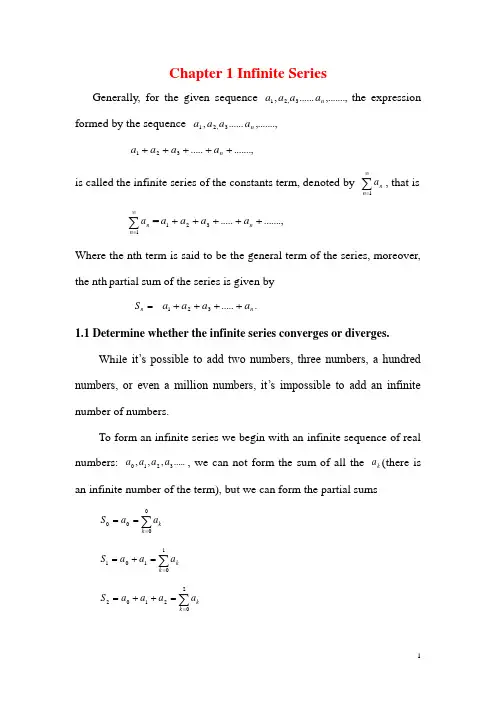
Chapter 1 Infinite SeriesGenerally, for the given sequence,.......,......,3,21n a a a a the expressionformed by the sequence ,.......,......,3,21n a a a a.......,.....321+++++n a a a ais called the infinite series of the constants term, denoted by ∑∞=1n n a , that is∑∞=1n n a =......., (32)1+++++n a a a aWhere the nth term is said to be the general term of the series, moreover, the nth partial sum of the series is given by=n S......321n a a a a ++++1.1 Determine whether the infinite series converges or diverges.Whil e it’s possible to add two numbers, three numbers, a hundred numbers, or even a million numbers, it’s impossible to add an infinite number of numbers.To form an infinite series we begin with an infinite sequence of real numbers:.....,,,3210a a a a , we can not form the sum of all the ka (there isan infinite number of the term), but we can form the partial sums∑===000k ka a S∑==+=1101k ka a a S∑==++=22102k ka a a a S∑==+++=332103k ka a a a a S……………….∑==+++++=nk kn n a a a a a a S 03210.......Definition 1.1.1If the sequence {n S } of partial sums has a finite limit L, We write∑∞==k ka Land say that the series ∑∞=0k k a converges to L. we call L the sum ofthe series.If the limit of the sequence {n S } of partial sums don’t exists, we say that the series ∑∞=0k k a diverges.Remark it is important to note that the sum of a series is not a sum in the ordering sense. It is a limit.EX 1.1.1 prove the following proposition: Proposition1.1.1: (1) If 1<xthen the ∑∞=0k k a converges, and ;110xx k k -=∑∞=(2)If,1≥xthen the ∑∞=0k kx diverges.Proof: the nth partial sum of the geometric series ∑∞=0k k a takes theform1321.......1-+++++=n n xx x x S ① Multiplication by x gives).......1(1321-+++++=n n xx x x x xS =nn xxx x x +++++-1321.......Subtracting the second equation from the first, we find thatnn xS x -=-1)1(. For ,1≠x this givesxxS nn --=11 ③If,1<x then→nx ,and this by equation ③.xxxS nn n n -=--=→→1111limlimThis proves (1).Now let us prove (2). For x=1, we use equation ① and device that,n S n =Obviously, ∞=∞→n n S lim, ∑∞=0k k a diverges.For x=-1 we use equation ① and we deduce If n is odd, then 0=n S ,If n is even, then.1-=n SThe sequence of partial sum nS like this 0,-1,0,-1,0,-1………..Because the limit of sequence }{n S of partial sum does not exist. By definition 1.1.1, we have the series ∑∞=0k K x diverges. (x=-1).For 1≠x with,1>x we use equation ③. Since in this instance, wehave -∞=--=∞→∞→xxS nn n n 11limlim . The limit of sequence of partial sum not exist,the series ∑∞=0k kxdiverges.Remark the above series is called the geometric series. It arises in so many different contexts that it merits special attention.A geometric series is one of the few series where we can actually give an explicit formula for n S ; a collapsing series is another.Ex.1.1.2 Determine whether or not the series converges ∑∞=++0)2)(1(1k k kSolution in order to determine whether or not this series converges we must examine the partial sum. Since2111)2)(1(1+-+=++k k k kWe use partial fraction decomposition to write2111111 (4)1313121211)2111()111(..............)4131()3121()2111()2)(1(1)1(1 (3).212.11+-+++-++-+-+-=+-+++-++-+-+-=++++++⨯+⨯=n n n n n n n n n n n n S nSince all but the first and last occur in pairs with opposite signs, the sum collapses to give211+-=n S nObviously, as.1,→∞→n S n this means that the series converges to 1.1)211(lim lim =+-=∞→∞→n S n n ntherefore 1)2)(1(10=++∑∞=n k kEX.1.1.3 proves the following theorem:Theorem 1.1.1 the kth term of a convergent series tends to 0; namely if∞=0k ka Converges, by definition we have the limit of the sequence}{n S ofpartial sums exists. NamelylaS nk kn n n ==∑=∞→∞→0limlimObviously.limlim 01l aS nk kn n n ==∑=∞→-∞→since1--=n n s s a n , we have0lim lim )(lim lim 11=-=-=-=-∞→∞→-∞→∞→l l S S S S a n n n n n n n n nA change in notation gives 0lim =∞→n k a .The next result is an obviously, but important, consequence of theorem1.1.1. Theorem 1.1.2 (A diverges test) iflim ≠∞→k k a , or ifn k a ∞→lim does not exist, then the series ∑∞=0k ka diverges.Caution, theorem 1.1.1 does not say that iflim =∞→k k a , and then∑∞=0k ka converge. In fact, there are divergent series for which 0lim=∞→k k a . Forexample, the series .....1 (2)11111++++=∑∞=nkk . Since it issequence }{n S of partial sum nn n n S n =>+++=1 (2)111}{ is unbounded. So∞===∞→∞→n S n n n limlim , therefore the series diverges.But01limlim ===∞→∞→k a k k kEX.1.1.3 determine whether or not the series:..........5443322101+++++=+∑∞=k k kConverges.Solution since 01111lim1limlim≠=+=+==∞→∞→∞→kk k a k k k k , this series diverges.EX.1.1.4 Determine whether or not the series ∑∞=021k kSolution1 thegivenseries is a geometric series.121,)21(0<==∑∑∞=∞=x and xk k k k,by proposition 1.1.1 we know that seriesconverges. Solution 2 ,21 (412)111-++++=n n S ① ,2121 (2)1212121132nn n S +++++=-②①-② (1-21))211(2,211nn nnS S-=-=.2)211(2lim lim =-=∞→∞→nn n n SBy definition of converges of series, this series converges.EX.1.1.5 proofs the following theorem:Theorem 1.1.2 If the series ∑∑∞=∞=0k k k k b and a converges, then (1))(0∑∞=+k k kb aalso converges, and is equal the sum of the two series.(2) If C is a real number, then ∑∞=0k k Ca also converges. Moreover iflak k=∑∞=0then ClCa k k=∑∞=0.Proof let∑∑====nk knnk knbS aS20)1(,∑∑===+=nk knnk k knCa Sb aS40)3(,)(Note that )1()4()2()1()3(nnnnnCSS andS S S =+=Since (),lim ,lim )2(1m S l S nn n n ==∞→∞→Thenm l S S S S S nn n n n n n nn +=+=+=∞→∞→∞→∞→)2()1()2()1()3(lim lim )(lim lim.lim lim lim )1()1()4(Cl S C CSS nn nn nn ===∞→∞→∞→Theorem 1.1.4 (squeeze theorem) Suppose that}{}{n n c and a both converge to l and thatnn n c b a ≤≤ for,k n ≥(k is a fixed integer), then }{n b also converges to l .Ex.1.1.6 show that 0sinlim3=∞→n nn .Solution For ,1≥n ,1)sin(13nnnn≤≤-since,0)1(lim ,0)1(lim ==-∞→∞→n and nn nthe result follows by the squeeze theorem.For sequence of variable sign, it is helpful to have the following result.EX1.1.7 prove that the following theorem holds.Theorem 1.1.5 If 0lim ,0lim==∞→∞→n n n n a then a ,Proof since,n n n a a a ≤≤-from the theorem 1.1.4Namely the squeeze theorem, we know the result is true.Exercise 1.1(1) An expression of the form 123a a a +++…is called(2) A series123a a a +++…is said to converge if the sequence {}S n converges, whereS n=1. The geometric series 2a ar ar +++…converges if; in this casethe sum of the series is 2. Iflim 0n n a →∞≠, we can be sure that the series1nn a∞==∑3. Evaluate 0(1),02k k r r r ∞=-<<∑.4. Evaluate 0(1),11k k k x x ∞=--<<∑.5. Show that 1ln 1k k k ∞=+∑diverges.Find the sums of the series 6-11 6. 31(1)(2)k k k ∞=++∑7.112(1)k k k ∞=+∑8.11(3)k k k ∞=+∑9.0310kk ∞=∑10.0345kkkk ∞=+∑11.3023k kk +∞=∑12. Derivethefollowingresultsfromthegeometricseries 221(1),||11k kk x x x∞=-=<+∑.Test the following series for convergence: 13. 11n nn∞=+∑ 14.312k k ∞+=∑1.2 Series With Positive T erms1.2.1 The comparison TestThroughout this section, we shall assume that our numbers n a are x≥,then the partial sum12n nS a a a =+++… are increasing, i.e.1231n n S S S S S +≤≤≤≤≤≤……If they are to approach a limit at all, they cannot become arbitrarily large. Thus in that case there is a number Bsuch thatn S B≤ for all n.Such a number Bis called an upper bound. By a least upper bound we mean a number Swhich is an upper bound, and such that every upperboundBis S ≥. We take for granted that a least upper bound exists. Thecollection of numbers {}n S has therefore a least upper bound, i.e., there is a smallest numbers such that n S S≤ for all n. In that case, the partialsumsn SapproachSas a limit. In other words, given any positivenumber 0ε>, we have n S S Sε-≤≤ for all n sufficiently large.This simply expresses the factSis the least of all upper bounds forour collection of numbers n S . We express this as a theorem.Theorem 1.2.1 Let {}(1,2,n a n =…) be a sequence of numbers≥and let 12n n S a a a =+++…. If the sequence of numbers {}n S is bounded,then it approaches a limit S , which is its least upper bound.Theorem 1.2.2 A series with nonnegative terms converges if and only if the sequence of partial sums is bounded above.Theorem 1.2.1 and 1.2.2 give us a very useful criterion to determine when a series with positive terms converges.The convergence or divergence of a series with nonnegative terms isusually deduced by comparison with a series of known behavior.S 1 S 2 S n STheorem 1.2.3(The Ordinary Comparison Test) Let 1n n a ∞=∑and1nn b ∞=∑be two series, with0n a ≥for all n and0n b ≥for all n. Assume thatthere is a numbers 0c >, such thatn na cb ≤ for all n, and that 1n n b ∞=∑converges, then 1n n a ∞=∑converges, and 11nnn n a c b ∞∞==≤∑∑.Proof: We have1212121()n n n nn a a a cb cb cb c b b b c b ∞=+++≤+++=+++≤∑……….This means that 1n n c b ∞=∑ is a bound for the partial sums 12n a a a +++….The least upper bound of these sums is therefore 1n n c b ∞=≤∑, thus proving ourtheorem.Theorem 1.2.3 has an analogue to show that a series does not converge.Theorem 1.2.4(Ordinary Comparison Test) Let 1n n a ∞=∑ and 1n n b ∞=∑ betwo series, withna and 0nb ≥ for all n. Assume that there is a number0c >such that n n a cb ≥for all n sufficiently large, and 1n n b ∞=∑ does notconverge, then 1n n a ∞=∑ diverges.Proof. Assume n na cb ≥forn n ≥, since 1n n b ∞=∑diverges, we canmake the partial sum0001Nn n n Nn n b b b b +==+++∑…arbitrarily large as N becomes arbitrarily large. But 0NNNn n nn n n n n n a cb c b ===≥=∑∑∑.Hence the partial sum 121NnNn a a a a ==+++∑… are arbitrarily large as Nbecomes arbitrarily large, are hence 1n n a ∞=∑ diverges, as was to be shown.Remark on notation you have easily seen that for each 0j ≥, 0k k a ∞=∑converges iff 1kk j a ∞=+∑converges. This tells us that, in determining whetheror not a series converges, it does not matter where we begin the summation, where detailed indexing would contribute nothing, we will omit it and write ∑without specifying where the summation begins. For instance, it makes sense to you that 21k∑converges and 1k∑diverges without specifying where we begin the summation. But in the convergent case it does, however, affect the sum. Thus for example122kk ∞==∑,1112kk ∞==∑,21122kk ∞==∑, and so forth.Ex 1.2.1 Prove that the series 211n n∞=∑converges.Solution Let us look at the series:22222222211111111112345781516+++++++++++………We look at the groups of terms as indicated. In each group of terms, if we decrease the denominator in each term, then we increase the fraction. We replace 3 by 2 , then 4,5,6,7 by 4, then we replace the numbers from 8 to 15 by 8, and so forth. Our partial sums therefore less than or equal to222222221111111112244488++++++++++………and we note that 2 occurstwice, 4 occurs four times, 8 occurs eight times, and so forth. Our partialsum are therefore less than or equal to222222221111111112244488++++++++++………and we note that 2 occurs twice, 4 occurs four times, 8 occurs eight times, and so forth. Hence the partial sums are less than or equal to2222124811124848+++++++1 (1)2Thus our partial sums are less than or equal to those of the geometric series and are bounded. Hence our series converges.Generally we have the following result: The series 1111111234pppppn nn∞==++++++∑……, wherepis a constant,is called a p-series.Proposition1.2.1. If 1p >, the p-series converges; and if 1p ≤, thenthe p-series diverges.Ex 1.2.2 Determine whether the series 2311n nn ∞=+∑converges.Solution We write2323111(1)1111nn nn nn==++++. Then we see that23111122nn nn ≥=+. Since 11n n∞=∑ does not converge, it follows that the series 2311n nn∞=+∑ does not converge either. Namely this series diverges.Ex 1.2.3 Prove the series 241723n n n n ∞=+-+∑converges.Proof :Indeed we can write2222424334477(1)171331123(2())2()n n nnn n n n n n n n+++==-+-+-+For n sufficiently large, the factor23471312()nn n+-+ is certainly bounded,and in fact is near 1/2. Hence we can compare our series with 21n∑ tosee converges, because ∑21nconverges and the factor is bounded.Ex.1.2.5 Show that 1ln()k b +∑diverges.Solution 1 We know that ask →∞,ln 0k k→. It follows that ln()0k b k b+→+, and thus thatln()ln()0k b k b k b kk bk+++=→+. Thus forksufficiently large, ln()k b k+< and11ln()kk b <+. Since 1k∑diverges,we can conclude that 1ln()k b +∑diverges.Solution 2 Another way to show that ln()k b k+< for sufficiently largekis to examine the function()ln()f x x x b =-+. At3x = thefunction is positive:(3)3ln 93 2.1970f =-=->Since '1()10f x x b=->+ for all 0x >, ()0f x > for all3x >. It followsthatln()x b x+< for all 3x ≥.We come now to a somewhat more comparison theorem. Our proof relies on the basic comparison theorem.Theorem 1.2.5(The Limit Comparison Test) Let k a ∑ and k b ∑ beseries with positive terms. If lim()k k ka lb →∞=, where l is some positivenumber, then k a ∑ and k b ∑converge or diverge together.Proof Choose ε between 0 and l , sincekka lb →, we know for allksufficiently large (for all k greater than some 0k ) ||k ka lb ε-<.For such k we have k ka l lb εε-<<+, and thus()()k k kl b a l b εε-<<+this last inequality is what we needed.(1) If k a ∑converges, then ()k l b ε-∑converges, and thuskb ∑converges.(2) If k b ∑converges, then ()k l b ε+∑converges, and thuska ∑converges.To apply the limit comparison theorem to a series k a ∑, we must first find a series k b ∑of known behavior for which k ka b converges to apositive number.Ex 1.2.6 Determine whether the series sin kπ∑converges ordiverges.Solution Recall that as sin 0,1x x x→→.As,k kπ→∞→ and thussin 1k kππ→. Sincekπ∑diverges, so sin()kπ∑diverges.Ex 1.2.7Determine whether the series 100∑converges ordiverges.Solution For large value of k,dominates the numeratorand22kthe denominator, thus, for such k,differs252k=. Since2210051020012k kk÷==→And 2255122kk=∑∑converges, this series converges.Theorem 1.2.6 Let k a ∑ and k b ∑ be series with positive terms and suppose thus0k ka b →, then(1) If k b ∑converges, then k a ∑converges. (2) If k a ∑diverges, then k b ∑diverges.(3) If k a ∑converges, then k b ∑may converge or diverge. (4) If k b ∑diverges, then k a ∑may converge or diverge. [Parts (3) and (4) explain why we stipulated 0l >in theorem 1.2.5]1.2.2 The root test and the ratio testTheorem 1.2.7 (the root test, Cauchy test) let ∑k a be a series with nonnegative terms and suppose thatρ==∞→∞→k k k kk k a a 1lim lim, ifρ<1, ∑k a converges, ifρ>1,∑ka diverges, ifρ=1, the test is inconclusive.Proof we suppose firstρ<1 and chooseμso that 1<<u ρ. Sinceρ→k k a 1)(, we have μ<kk a 1, for all k sufficiently large thus kk a μ< for allk sufficiently large since ∑k μ converges (a geometric series with 0<1<μ), we know by theorem 1.2.5 that∑ka converges.We suppose now that1>ρand chooseμso that 1>>u ρ. sinceρ→k k a 1)(, we haveμ>k k a 1)( for all k sufficiently large. Thuskk a μ>for all k sufficiently large.Since ∑k μ diverges (a geometric series with 1>μ ) the theorem1.2.6 tell us that ∑k a diverges.To see the inconclusiveness of the root test when 1=ρ, note that1)(1→k k a for both:112∑∑kandk,11)1()1()(221121=→==kk k k kka 11)1()(11→==k k k k kk aThe first series converges, but the second diverges. EX.1.2.7 Determine whether the series ∑kk )(ln 1converges ordiverges.Solution For the series ∑kk )(ln 1, applying the root test we have0ln 1lim)(lim 1==∞→∞→ka k kk k , the series converges.EX.1.2.8 Determine whether series ∑3)(2k k converges or diverges.Solution For the series ∑kk )3(2, applying the root test, we have1212]1[2)1(.2)(3331>=⨯→==kk k k kka . So the series diverges.EX1.2.9 Determines whether the series kk∑-)11(converges ordiverges.Solution in the case of kk∑-)11(, we have 111)(1→-=ka kk . Ifapplying the root test, it is inconclusive. But since kkka )11(-=convergestoe1 and not to 0, the series diverges.We continue to consider only series with terms≥. To comparesuch a series with a geometric series, the simplest test is given by the ratio test theoremTheorem 1.2.8 (The ratio test, DAlembert test) let ∑k a be a series with positive terms and suppose thatλ=+∞→kk k a a 1lim,If ,1<λ∑k a converges, if,1>λ∑ka diverges.If the,1=λthe test is inconclusive.Proof we suppose first that,1<λsince1lim1<=+∞→λkk k a aSo there exists some integer N such that if n ≥NCa a nn ≤+1 ThenNN N N N a C Caa Caa 212,1≤≤≤+++ and in general byinduction,N kk N a C a ≤+Thusca c c c c a a c a c ca a aNkN N kN N N kN Nn n-≤++++≤++++≤∑+=11)........1( (3)22Thus in effect, we have compared our series with a geometric series, and we know that the partial sums are bounded. This implies that our series converges.The ratio test is usually used in the case of a series with positive terms nasuch that.1lim1<=+∞→λnn n a aEX.1.2.10 show that the series ∑∞=13n n nconverges.Solution we let ,3nn n a =then31.13.3111n n n n a a nn nn +=+=++,this ratioapproaches∞→n as 31, and hence the ratio test is applicable: the seriesconverges.EX1.2.11 show that the series ∑!k kkdiverges.Solution we have kkkk nn kkk kk k k a a )11()1(!)!1()1(11+=+=++=++Soe ka a kk nn n =+=∞→+∞→)11(lim lim1Since 1>e , the series diverges. EX.1.2.12 proves the series ∑+121k diverges.Solution sincekk k k k k a a k k 32123212112.1)1(211++=++=+++=+ 13212limlim1=++=∞→+∞→kk a a k kk k .Therefore the ratio test is inconclusive. We have to look further. Comparison with the harmonic series shows that the series diverges:∑++=+>+)1(21,11.21)1(21121k k k k dverges.Exercise 1.21. The ordinary comparison test says that if ____ and if ∑i b converges. Then ∑k a also converges.2. Assume that 00>≥k kb and a . Thelimit comparison Test says that if0<____<+∞ then ∑k a and ∑k b converges or diverge together. 3. Let nn n a a 1lim+∞→=ρ. The ratio Test says that a series ∑k a of positive termsconverges if ___, diverges if ____and may do either if ___. Determine whether the series converges or diverges 4. ∑+13kk 5. ∑+2)12(1k 6. ∑+11k 7. ∑-kk2218. ∑+-1tan 21kk9. ∑321k10. ∑-k)43( 11. ∑k kln 12. ∑!10k k13. ∑kk1 14. ∑kk 100! 15. ∑++kk k623216. kk ∑)32( 17.∑+k11.18. ∑kk 410!19. Let}{n a be a sequence of positive number and assume thatna a nn 111-≥+ for all n. show that the series ∑n a diverges.1.3 Alternating series, Absolute convergence and conditional convergenceIn this section we consider series that have both positive and negative terms.1.3.1 Alternating series and the tests for convergence The series of the form .......4321+-+-u u u u iscalled the alternatingseries, where 0>n ufor all n, here two example:∑∞=--=+-+-+-11)1( (6)1514131211n n n,11)1( (6)5544332211+-=+-+-+-∑∞=n nnWe see from these examples that the nth term of an alternating series is the form n n n n n nu a or u a )1()1(1-=-=-,wherenu is a positive number (infact nna u =.)The following test says that if the terms of an alternating series decrease toward 0 in absolute value, then the series converges. Theorem 1.3.1 (Leibniz Theorem) If the alternating series n n nu ∑∞=-1)1(satisfy:(1)1+≥n n u u(n=1,2………); (2)lim =∞→n n u ,then the series converges. Moreover, it is sum 1u s ≤, and the error nr makeby usingn s of the first n terms to approximate the sum s of the series isnot more than 1+n u , that is, 1+≤n n u r namely 1+≤-=n n n u s s r .Before giving the proof let us look at figure 1.3.1 which gives a picture of the idea behind the proof. We first plot 11u s =on a number line.To find2swe subtract 2u , so 2s is the left of 1s . Then to find3s weadd 3u , so 3s is to the right of 2s . But, since3u <2u ,3s is to the left of 1s .Continuing in this manner, we see that the partial sums oscillate back and forth. Since 0→nu , the successive steps are becoming smaller and smaller.The even partial sums ,........,,642s s s areincreasing and the odd partialsums,........,,531s s s aredecreasing. Thus it seems plausible that both areconverging to some number s, which is the sum of the series. Therefore, in the following proof we consider the even and odd partial sums separatelyWe give the following proof of the alternating series test. We first consider the even partial sums:,0212≥-=u u s Since 12u u ≤,)(24324s u u s s ≥-+= since uu ≤4 In general, 22212222)(---≥-+=n n n n n s u u s s since122-≤n n u uThus.........................02642≤≤≤≤≤≤n s s s sBut we can also writenn n n u u u u u u u u s 21222543212)(....)()(--------=--Every term in brackets is positive, so 12u s n ≤for all n. therefore, thesequence }{2n s of even partial sums is increasing and bounded above. It is therefore convergent by the monotonic sequence theor em. Let’s call it is limit s, that is, s s n n =∞→2limNow we compute the limit of the odd partialsums:sconditionby s u s u s s n n n n n n n n n =+=+=+=+∞→∞→+∞→+∞→))2((0lim lim )(lim lim 12212212Since both the even and odd partial sums converge to s, wehave s s n n =∞→lim , and so the series is convergent.EX.1.3.1 shows that the following alternating harmonic series is convergent:.)1(..........413121111∑∞=--=+-+-n n nSolution the alternating harmonic series satisfies (1)nu n u n n 1111=<+=+; (2)1limlim ==∞→∞→nu n n nSo the series is convergent by alternating series Test. Ex. 1.3.2 Test the series ∑∞=--1143)1(n nn n for convergence and divergence.Solution the given series is alternating but043143lim143limlim ≠=-=-=∞→∞→∞→nn n u n n n nSo condition (2) is not satisfied. Instead, we look at the limit of the nthterm of the series:143)1(limlim --=∞→∞→n n a n n n This limit does not exist, so the series diverges bythe test for divergence. EX.1.3.3 Test the series ∑∞=+-121)1(n nn for convergence or divergence.Solution the given series is alternating so we try to verify conditions (1) and (2) of the alternating series test.Unlike the situation in example 1.3.1, it is not obvious the sequence given by12+=n n u n is decreasing. If we consider the related function1)(2+=x x x f ,we easily find that10)1(1)1(21)(22222222'><+-=+-+=xwhenver x xx x x x f .Thus f is decreasing on [1,∞) and so )1()(+>n f n f .Therefore, }{n u isdecreasingWe may also show directly that nn u u <+1, that is11)1(122+<+++n n n nThis inequality it equivalent to the one we get by cross multiplication:nn n n n n n n n n n n n n n n +<⇔++<+++⇔++<++⇔+<+++2232322221221]1)1[()1)(1(11)1(1Since 1≥n , we know that the inequality12>+n n istrue. Therefore,n n u u <+1and }{n u is decreasing.Condition (2) is readily verified:。

微积分课件完整版微积分课件完整版微积分(Calculus)是高等数学中研究函数的微分(Differentiation)、积分(Integration)以及有关概念和应用的数学分支。
它是数学的一个基础学科.内容主要包括极限、微分学、积分学及其应用。
微分学包括求导数的运算,是一套关于变化率的理论.它使得函数、速度、加速度和曲线的斜率等均可用一套通用的符号进行讨论。
积分学,包括求积分的运算,为定义和计算面积、体积等提供一套通用的方法。
词目释义从17世纪开始,随着社会的进步和生产力的发展,以及如航海、天文、矿山建设等许多课题要解决,数学也开始研究变化着的量,数学进入了“变量数学”时代。
整个17世纪有数十位科学家为微积分的创立做了开创性的研究,但使微积分成为数学的一个重要分支的还是牛顿。
(1)运动中速度与距离的互求问题求物体在任意时刻的速度和加速度;反过来,已知物体的加速度表为以时间为变量的函数公式,求速度和距离.这类问题是研究运动时直接出现的,困难在于,所研究的速度和加速度是每时每刻都在变化的。
比如,计算物体在某时刻的瞬时速度,就不能像计算平均速度那样,用移动的距离去除运动的时间,因为在给定的瞬间,物体移动的距离和所用的时间是是无意义的。
但是,根据物理,每个运动的物体在它运动的每一时刻必有速度,这也是无疑的。
已知速度公式求移动距离的问题,也遇到同样的困难.因为速度每时每刻都在变化,所以不能用运动的时间乘任意时刻的速度,来得到物体移动的距离。
(2)求曲线的切线问题这个问题本身是纯几何的,而且对于科学应用有巨大的重要性。
由于研究天文的需要,光学是十七世纪的一门较重要的科学研究,透镜的设计者要研究光线通过透镜的通道,必须知道光线入射透镜的角度以便应用反射定律,这里重要的是光线与曲线的法线间的夹角,而法线是垂直于切线的,所以总是就在于求出法线或切线;另一个涉及到曲线的切线的科学问题出现于运动的研究中,求运动物体在它的轨迹上任一点上的运动方向,即轨迹的切线方向.(3)求长度、面积、体积、与重心问题等这些问题包括,求曲线的长度(如行星在已知时期移动的距离),曲线围成的面积,曲面围成的体积,物体的重心,一个相当大的物体(如行星)作用于另一物体上的引力。